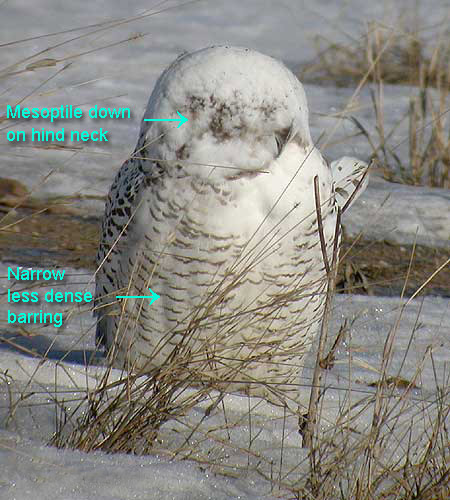|
Age and Gender
of Snowy Owl in Markham near Toronto |
| 5 photos
on 6 January 2006 |
|
In winter there are four
age and gender classes of the Snowy Owl: first year males, first
year females, adult males and adult females. Birds after their
second prebasic molt are considered adults. First year females are
heavily marked and can be identified in the field with reasonable
certainty. Adult males tend to be the least marked and whitest.
First year males and adult females are most similar. I aged this
Snowy Owl as a first year male in first year (formative)
plumage. Note loose secondary feather. Below are the points used to
determine its age and gender. |
|
 |
|
Photo 1. Extensive mottling of the
greater coverts (photo above) and tertials (photo 4) indicates a first year male. This bird also has
mottling on lower scapulars, which adult females do not have. See also
Photo 4. Mottling or gray dappling on the tertials
and coverts is found in both first year males and females, varying from dark and
extensive to slight. Adult females can have slight mottling of the
greater primary coverts and distal tips of primaries. |
| |
|
 |
|
Photo 2. Front view with
head turned away. First year males have narrow and less dense ventral
bars than females, which have significantly thicker and denser
barring. They can have a dark patch of mesoptile down on the
hind neck. See also Photos 3. |
| |
|
 |
|
Photo 3. Back and side
view with head turned. On first year males, the
mantle, scapulars, back, upper wing coverts are white with narrow gray-brown crescent-like bars,
not as half moon shaped as adult females. Back of the head shows the
retained small patch of mesoptile feathers.The loose feather is a
secondary. |
|
|
|
 |
|
Photo 4. Back view. Extensive mottling on the
lower scapulars, tips of primaries, and tertials indicates a first year male.
Adult females do not have mottling on lower scapulars. First year
males have narrower tail bars than adult females. |
|
|
|
|